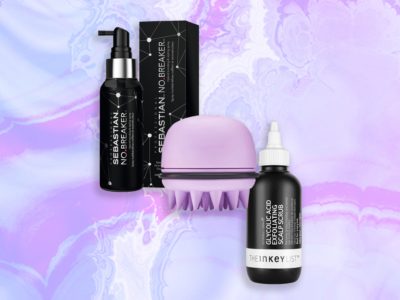
This year is Allure’s 30th Anniversary, and we’re celebrating by looking back at iconic moments in beauty from the past three decades. You can read more articles like this one here.
“The history of skin care may one day be divided into its own epochs: B.B. (Before Botox) and A.B. (After Botox).” Truer words have never been written — in the beauty realm, at least. That sentence, published in December 2007, is one of 331 times that we at Allure have critiqued, exalted, and investigated Botox since the FDA green-lit it for vaporizing wrinkles in April 2002. Botox is the brand name of the first neurotoxin injectable and those five letters are beauty’s Google or Kleenex or Frisbee. There may now be other neurotoxins that smooth away lines by blocking the nerve impulses that cause muscle activity, but Botox is the name that’s etched into our minds, imaginations, and cultural consciousness. Here, our nine favorite moments in Allure’s reporting on exogenous chemical neurological insults. (See? Doesn’t have the same ring to it.)
Under-the-radar, under your skin
Doctors began experimenting with botulinum toxin type A’s line-erasing prowess back when it was only FDA-approved for eye muscle disorders, and Allure was there reporting on its more under-the-radar cosmetic uses in the 1990s. In 1998’s “Pretty Poison,” legendary Allure editor Joan Kron (her pioneering beat was covering advances in plastic surgery and dermatology) reported, “FDA supplies are running out as patients are begging for more injections — in their crow’s-feet, necks, or right between the eyes.”
It’s just Botox
The April 2002 news that the FDA had officially sanctioned Botox to Magic-Erase frown lines was met with mixed emotions (jubilation, apprehension, confusion, to name three). Writer David DeNicolo (now Allure‘s editor at large) chimed in later that year: “Should people risk injection with a deadly neurotoxin to look younger? Will the human face as we know it be replaced by a frozen, expressionless mask? And why, oh why, are we so vain? The short answers to those questions are: 1) the toxin is, of course, rendered harmless before injection, 2) we haven’t become Zombie Nation yet, and 3) for heaven’s sake, read a history book.… Yes, some people will use it to excess and look odd, just as some people use makeup to excess and look odd. Sometimes people like to look odd. And sometimes Botox is just Botox.”
Take a shot (or 2.8 million)
That’s how many Botox shots were administered in its first full year as a cosmetic treatment, a pretty impressive show of support. But the notion of injecting a toxin still took some getting used to for, oh, most of the country. The hesitation was understandable: A single gram of botulinum toxin in crystalline form could kill more than one million people if it was dispersed and inhaled. But if highly processed, highly purified, injectable Botox could kill you, “half of Beverly Hills would be dead,” dermatologist Ava Shamban assured our readers in November 2004.
Still controversial at 10
In April 2012, on the occasion of Botox’s 10th cosmetic-approval birthday (it didn’t look a day over eight), writer Daphne Merkin was critical: “Botox. The very word has become charged, a signifier for something larger than itself and a judgment on the phenomenon. As in: She looks Botoxed.… There is still an argument to be made that along the way to losing our wrinkles we have also lost sight of the natural aging process.” The late dermatologist Fredric Brandt (dubbed the Baron of Botox) lamented unskilled injectors: “It’s not the same as getting a manicure. It requires an artistic approach to get a natural result.”
Refining the technique
The longer Botox was around, the more dermatologists honed their techniques for injecting it — and the less the word was used as a derogatory adjective. New, more nuanced methods were cause for celebration in January 2018’s “For the Love of Laugh Lines.” “Doctors who used to use injections to erase crow’s-feet indiscriminately are softening their approach.… It can be liberating to recalibrate the way we consider crow’s-feet,” wrote deputy beauty director Elizabeth Siegel. “To see them as something to be celebrated and embraced, not wiped away or wished away or filled or frozen… ‘Your crow’s-feet are the story of who you are,’ says [dermatologist Ranella] Hirsch. ‘They speak of a joyous life laughing, and that is truly beautiful.'”
Yet another reason to love injectables…
In our February 2017 issue, we asked “Is Botox Feminist?” and Lindsy Van Gelder examined the pink tax: “There are a few tiny — but substantial! — corners where men pay more than we do. Call it the pink rebate.” And, yes, that’s right: Botox costs men about twice as much as it does women — their stronger facial muscles require around double the number of units to become incapacitated. (For the record: In 2019, six percent of neurotoxin injections were given to men — not a huge number, but a five percent increase over the previous year.)
Freeze your lines, freeze your sadness?
Researchers have been studying Botox as a depression treatment for some time, and in late 2018 senior writer Brennan Kilbane visited one of a (very) few physicians board-certified in both dermatology and psychiatry to test the hypothesis firsthand. “When examining the lines of my face, the doctor asks me to contort my features into a variety of different non-sad expressions, which makes me feel as though I am rehearsing for a new period of my life in which I feel a variety
of different non-sad emotions.” And a week later? “The Botox calcifies, rendering my forehead useless. My emotional inventory is limited to a handful of available expressions: closed-mouth smile, open-mouth smile, enormous cartoon grin. But instead of unbridled happiness and joy bursting forth from my every nose pore, I don’t feel a thing. I don’t feel bad, but I don’t feel fantastic, either. To strangers, I look like I’m either feeling happy or nothing at all.” While clinical trials are ongoing, there was one research win last year out of the University of California San Diego: Patients who had Botox reported depression significantly less often than patients undergoing other treatments for the condition.
Welcome to the Wild West
As our collective appetite for Botox has grown so has a murky gray area, which we investigated in 2018’s “Needle Nation”: “[The proliferation of injectables] kind of came out of nowhere and took off faster than states could figure out how to regulate them. So now your hair salon might ask you to decide between bangs or Botox,” wrote Siegel. (You always have to have a medical license to buy Botox, but not to inject it.) “When so many people want to shove stuff into your lips or crow’s-feet, it’s time to acknowledge that we are in the Wild West.” And that is a dangerous place to be: Botox “‘is a medical procedure. And more so, a medical procedure for your face. No one believes that as much as the person who’s had it go wrong,’ says Hirsch.”
…and thank God for Westport, Ireland!
And in early 2019, executive beauty director Jenny Bailly journeyed back to the beginning. “I have been to the place that produces the entire planet’s supply of the wrinkle-smoothing, brow-raising drug, and here is how I got there: by flying into Dublin (the one in Ireland) and driving 156 miles, clear across the country, to a village nestled in a craggy, wind-lashed coastline.” Westport, Ireland, has a population of more than 6,000, many of whom work at a plant on the edge of town that has produced all the Botox since 1994. “Whether you’re in Hollywood or acting in London’s West End, your Botox is 100 percent guaranteed Irish,” one longtime Westporter, Simon Wall, boasted to Bailly, who learned about more than just Botox history and chemistry during her time in Westport. “If you subscribe to Celtic mythology, somewhere out in these western Irish seas is Tír na nÓg, ‘the land of youth.’ In this otherworld, no one ever grows old and nothing fades. It’s like the people there know of an elixir that can defy time. Imagine that.”
Read more about injectables on Allure:
Now, watch Pharrell and his dermatologist answer common skincare questions:





